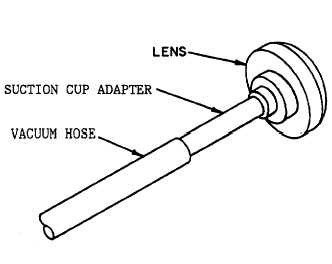|
| |
TM 9-254
9-3.
Cleaning Optical Components - Continued
(3)
Lenses may also be cleaned without removing them from the cell. Cleaning the component is
accomplished in the same manner as described in (2) above. Cleaning of the lens should start at its
center and progress to its outer edge. Move the applicator to the edge of the lens cell and bring it off of
the lens. Care must be taken to prevent leaving marks or streaks on the lens. Repeat this process on
each side of the lens until it is free of dirt and lint.
(4)
Use of the syringe and the vacuum system are the most common methods for removing dirt and lint
from the surfaces of lenses and lens cells. The syringe can be used in most cases, but it may just blow
the dirt or lint off the lens and onto some other part of the cell or instrument. The vacuum system is the
most efficient for dirt removal. A vacuum draws the dirt into the system and does not move the dirt
around. Also, a suction adapter (fig. 9-24) can be used with a vacuum system to hold lenses for
cleaning. A vacuum system should be supplied throughout the shop from a central pump with
connections at each individual bench.
9-4.
Storing and Handling Optical Components.
a.
Care. Optical components should always be handled with extreme care. Components not handled properly
may be damaged to an extent that necessitates regrinding, repolishing, or discarding the component completely.
b.
Storing and Protecting Components. Optical components, whether new or used should be protected by
keeping them in an out-of-the way place. A lens tray, with a felt lining on the bottom and a cover over it is a good way to
keep components from being damaged. This also keeps excessive dust from settling on the components. Any time a
component is not going to be used for a period of time, it should be wrapped in lens tissue and stored in a protective
container.
c.
Use of Holding Devices. In cleaning optical components it is sometimes necessary to use holding devices on
small thin lenses or reticles. They should be held with lens tongs equipped with rubber protectors on the jaws to prevent
chipping of the lens. In shops equipped with a central vacuum system, lenses may also be held with a suction cup adapter
placed on a vacuum hose as shown in figure 9-24.
Figure 9-24. Suction Cup Adapter
Change 2 9-17
|

